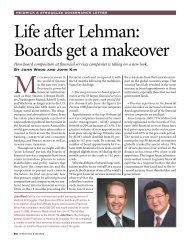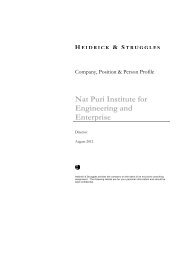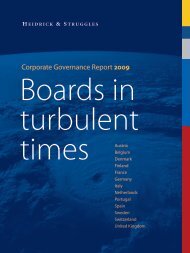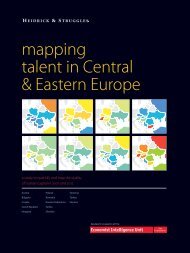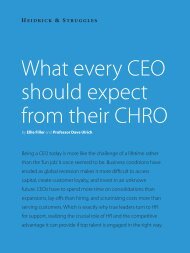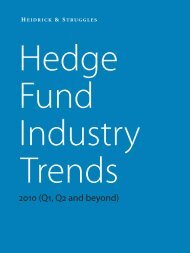Hedge Fund Industry Trends - 2009 and Beyond - Heidrick & Struggles
Hedge Fund Industry Trends - 2009 and Beyond - Heidrick & Struggles
Hedge Fund Industry Trends - 2009 and Beyond - Heidrick & Struggles
Create successful ePaper yourself
Turn your PDF publications into a flip-book with our unique Google optimized e-Paper software.
Very significant increase in capital allocation or responsibility<br />
Upgrade to more distinguished top-tier institution/firm with many/most of the factors<br />
listed above<br />
Opportunity to build firm as well as invest, <strong>and</strong>/or opportunity to be key part of a firm’s<br />
succession plan<br />
Opportunity to serve a cause while investing: Major endowments, sovereign wealth<br />
funds, <strong>and</strong> the SEC have made key hires in <strong>2009</strong> where c<strong>and</strong>idates were attracted to the<br />
cause /mission associated with the institution as well as the investment opportunity<br />
Significant/sufficient capital to start own fund or significant allocation on a well<br />
managed platform with competitive <strong>and</strong> transparent economics<br />
II. FIRMS WHERE TALENT IS VULNERABLE<br />
Clearly, these firms would lack some or all of the five characteristics of firms from where<br />
talent is stable. However, in surveying PM c<strong>and</strong>idates we identified the following eight key<br />
characteristics of firms where talent is not locked in.<br />
1) Firm underperformance: Clearly a main driver of talent flow: However there are<br />
two types of underperformance. PMs underperformance <strong>and</strong>/or firm<br />
underperformance but where the PM has performed well. Please note that for this<br />
Report we focus on the latter situation only, though it should be noted the former<br />
situation – PM underperformance – is often what causes the most noise in the<br />
marketplace <strong>and</strong> these c<strong>and</strong>idates make use of the factors listed below as reasons<br />
for wanting to seek new opportunities.<br />
The easiest targets are firms that have not reached their high-water mark. We have<br />
found that loyalty to a firm lasts about two years (two consecutive years of little/no<br />
bonus with uncertainty regarding year three bonus) unless one is a senior member<br />
of the firm where significant personal wealth accumulation has already occurred. In<br />
2010, many funds will have reached this two year mark.<br />
2) Firms without formulaic payouts for PMs: Situations where there was no<br />
formula but more of a h<strong>and</strong>shake deal or subjective payout. Given the<br />
opportunities that will be available in Q1 2010 <strong>and</strong> given recent events, this type of<br />
deal could be less acceptable for many high performing PMs.<br />
3) Firms where portfolios are shared: While not eager to leave, most c<strong>and</strong>idates<br />
who share a portfolio are open to discussions. High performing PMs perceive a<br />
mismatch between economics <strong>and</strong> contribution levels for higher level performers,<br />
though it should be noted that no mismatch is perceived when firm performance<br />
exceeds individual PM performance.<br />
4) Traditionally centralized structures: A structure where PMs don't run specific<br />
books but instead contribute their sleeve to a multi-strategy fund or to a Senior<br />
PM/Founder/CIO. People here may be inclined to look for portfolio autonomy<br />
elsewhere. Some Senior Analyst/ Junior PM level talent may face a cap on<br />
development <strong>and</strong> autonomy at certain firms as well. Several PMs <strong>and</strong> Analysts<br />
<strong>Hedge</strong> <strong>Fund</strong> <strong>Industry</strong> <strong>Trends</strong>, <strong>2009</strong> 14<br />
0010159





